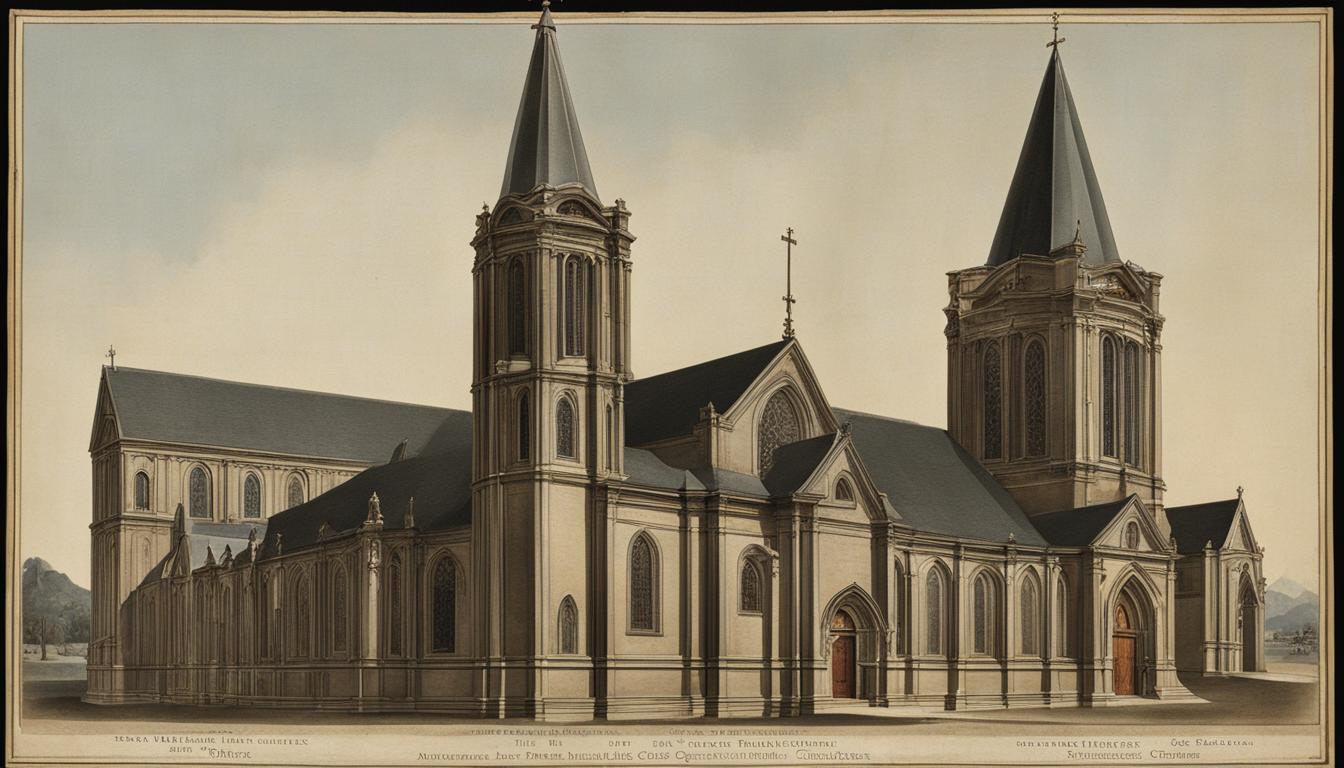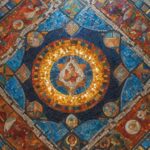Monasticism has long been an important aspect of Christian spirituality, with influential figures shaping its practice and ideals throughout history. From prominent spiritual teachers to celebrated monastic figures, these leaders have left a lasting impact on the development of monasticism. In this comprehensive guide, we will delve into the lives and contributions of key figures in monasticism, exploring their significance and the legacy they have left behind.
Key Takeaways
- Monasticism is a structured, ascetic pursuit of the Christian life.
- Key figures in monasticism have played significant roles in shaping the practice and values of monasticism.
- Monasticism has had a profound impact on various areas such as education, culture, manuscript preservation, medicine, and art.
- The origins of monasticism can be traced back to pre-Christian influences, such as Jewish ascetics and communal living.
- Early monastic figures like the Desert Fathers and Basil of Caesarea have laid the foundation for monasticism.
The Origins of Monasticism
The origins of monasticism can be traced back to early influences such as Jewish ascetics like the Nazirites, the Qumran Community, the Essenes, and the Therapeutae. These groups practiced various forms of asceticism, communal living, and spiritual disciplines that later influenced the development of Christian monasticism.
The Jewish ascetics, known as Nazirites, vowed to live a life of abstinence and separate themselves from certain worldly pleasures. The Qumran Community, which is famous for the discovery of the Dead Sea Scrolls, practiced communal living and devoted themselves to strict religious observance. The Essenes, another Jewish sect, also engaged in communal living and practiced strict adherence to purity rituals and spiritual disciplines.
The Therapeutae were a Jewish sect in Egypt who emphasized a monastic lifestyle. They dedicated themselves to prayer, contemplation, and the pursuit of spiritual enlightenment. These pre-Christian influences on ascetic living and spiritual devotion laid the foundation for the monasticism that would develop within Christianity.
Table: Pre-Christian Influences on Monasticism
| Group | Practices |
|---|---|
| Nazirites | Abstinence, separation from worldly pleasures |
| Qumran Community | Communal living, strict religious observance |
| Essenes | Communal living, purity rituals, spiritual disciplines |
| Therapeutae | Prayer, contemplation, pursuit of spiritual enlightenment |
The early monastic figures in Christianity drew inspiration from these pre-Christian examples of ascetic living and spiritual devotion. They expanded on these practices, incorporating Christian teachings and values into their monastic lifestyles. The influence of these early monastic figures would continue to shape the development of monasticism in the following centuries.
Early Monastic Figures
Early monasticism was shaped by influential figures who laid the foundation for the development of the Christian monastic tradition. These figures, known as the Desert Fathers, played a significant role in shaping the spiritual practice of monasticism.
One of the most renowned figures among the Desert Fathers was Anthony of Egypt. He was an ascetic monk who lived a life of solitude in the Egyptian desert. His commitment to prayer, fasting, and contemplation inspired many others to follow in his footsteps.
Basil of Caesarea was another important figure in early monasticism. He founded Eastern monasticism and emphasized community living and communal prayer. His writings and teachings influenced the development of monastic communities throughout the East.
Benedict of Nursia, often referred to as the father of Western monasticism, contributed to the shaping of monasticism in the West. He established the Rule of Saint Benedict, which outlined the way of life for monks and emphasized obedience, humility, and simplicity.
The lives and teachings of these early monastic figures continue to inspire those who seek a life of devotion, prayer, and spiritual discipline.
“The Desert Fathers were the pioneers of monasticism, showing us the path of solitary contemplation and inner transformation.” – Anonymous
Table: Comparison of the Lives and Contributions of Anthony of Egypt, Basil of Caesarea, and Benedict of Nursia
| Anthony of Egypt | Basil of Caesarea | Benedict of Nursia | |
|---|---|---|---|
| Lifespan | 251-356 AD | 329-379 AD | 480-547 AD |
| Key Teachings | Emphasis on solitude, asceticism, and prayer | Importance of communal living, communal prayer, and theological writings | Rule of Saint Benedict, emphasizing humility, obedience, and community life |
| Impact | Inspired many to follow the monastic way of life in the desert | Founded Eastern monasticism, influenced the development of monastic communities | Established the Rule that became the guide for Western monastic practice |
The lives and teachings of Anthony of Egypt, Basil of Caesarea, and Benedict of Nursia continue to resonate with individuals seeking a deeper spiritual connection and a more intentional way of living. Their legacies serve as a guiding light for those who embrace the monastic tradition.

Celtic Monasticism
Celtic monasticism emerged as a distinct branch of the monastic tradition, characterized by its unique practices and spiritual focus. The Celtic monks embraced a lifestyle that encompassed not only prayer and asceticism but also a deep connection with nature and the surrounding landscape. Their approach to monasticism was marked by peregrination, or wandering without a fixed destination, allowing them to experience God’s presence in different places and encounters.
One of the notable aspects of Celtic monasticism was its emphasis on book production. Celtic monks were known for their meticulous work in creating beautifully illuminated manuscripts, such as the famous Book of Kells. These manuscripts not only served as spiritual tools but also preserved invaluable knowledge and cultural heritage.
Furthermore, Celtic monks were active in missionary work, spreading the teachings of Christianity throughout the British Isles and even beyond. They played a crucial role in the conversion of pagan societies and the establishment of Christian communities. Their commitment to sharing the gospel and their willingness to venture into unknown territories exemplified their dedication to their faith.
| Unique Practices of Celtic Monasticism | Examples |
|---|---|
| Peregrination | The practice of wandering without a fixed destination, seeking encounters with God in different places. |
| Book Production | The creation of beautifully illuminated manuscripts, preserving knowledge and cultural heritage. |
| Missionary Work | Spreading the teachings of Christianity and establishing Christian communities. |
“The Celtic monks embarked on a journey of faith, both internally and externally, allowing their peregrination and book production to be vehicles for encountering God and sharing His message,”
In summary, Celtic monasticism stood out for its unique practices, emphasis on peregrination, dedication to book production, and active participation in missionary work. These Celtic monks left a lasting legacy through their manuscripts, spiritual teachings, and contributions to the spread of Christianity. Their commitment to seeking God in nature, producing intricate manuscripts, and sharing the gospel continues to inspire individuals on their own spiritual journeys.
New and Old Monasticism
The term “new monasticism” refers to the emergence of modern monastic communities that recognize their connection to the tradition of monasticism. These communities have a renewed vision of the Christian gospel and challenge modern secular culture. They offer a fresh perspective on monasticism and its relevance in today’s world.
Modern monastic communities embody the core principles of monasticism, such as prayer, contemplation, simplicity, and community. However, they also adapt to the needs and realities of the contemporary world. They engage in social justice work, advocate for environmental sustainability, and promote spiritual formation in the midst of the busyness and distractions of modern life.
These communities attract individuals from various backgrounds, including young adults seeking a deeper spiritual connection, professionals desiring a more intentional way of living, and retirees exploring new paths towards spiritual growth. They provide a supportive environment for individuals to live out their faith and explore the ancient practices and wisdom of monasticism in a modern context.
Examples of Modern Monastic Communities
Several modern monastic communities have gained recognition for their innovative approach to monasticism. The following are just a few examples:
- Community A: A diverse and inclusive community that promotes interfaith dialogue and welcomes individuals from all walks of life.
- Community B: Focuses on sustainable living and environmental stewardship, incorporating sustainable farming practices and renewable energy sources into their daily lives.
- Community C: Emphasizes social justice and stands in solidarity with marginalized communities. They actively advocate for human rights, equality, and peace.
These communities demonstrate the adaptability and resilience of monasticism throughout history and its ability to respond to the changing needs of society. By marrying ancient wisdom with contemporary challenges, they offer a hopeful and transformative vision for the future of monasticism.
The Fourth Century and the Spread of Monasticism
The fourth century played a pivotal role in the expansion and development of monasticism. During this time, several influential figures emerged, including Isaac of Egypt, Anthony of Egypt, and Pachomius, who contributed to the growth of monastic communities and the spread of ascetic practices.
“Isaac of Egypt, also known as Saint Isaac the Syrian, is considered the first monk, and his teachings on inner stillness and contemplative prayer greatly influenced later monastic traditions,” said renowned monastic scholar Dr. Elizabeth Gibson.
Anthony of Egypt, often referred to as Saint Anthony, attracted numerous followers to the desert as he sought a life of solitude and spiritual discipline. His example inspired many others to pursue the monastic path.
Pachomius, a former soldier, established large and regulated monastic communities in Upper Egypt. His innovative approach provided a structured and secure way of life for those seeking a shared experience of asceticism and communal living.
The contributions of these figures, along with the communal lifestyle they fostered, facilitated the rapid expansion of monasticism during the fourth century. It laid the foundation for the continued growth and influence of monastic communities throughout history.
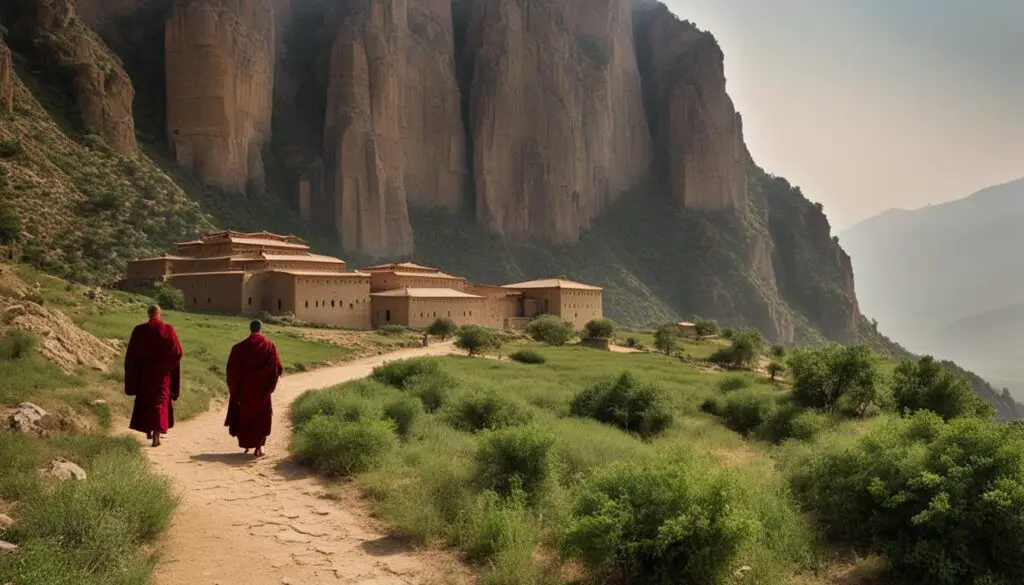
The Spread of Monasticism: Key Figures and Milestones
| Figure | Role |
|---|---|
| Isaac of Egypt | Considered the first monk and influential in contemplative prayer |
| Anthony of Egypt | Attracted followers to the desert and inspired others to pursue monasticism |
| Pachomius | Established regulated monastic communities in Upper Egypt |
The table above highlights the key figures in the fourth century who played a significant role in the spread of monasticism. Their teachings and examples continue to inspire individuals in their own pursuit of a deeper spiritual life.
Beginnings of Monasticism
The origins of monasticism can be traced back to its roots in the Bible and the cultural context of the time. The desert, in particular, held great significance as a place of encounter with God, where individuals sought solitude and experienced transformation. The early monastic figures were inspired by biblical examples of individuals like Elijah and John the Baptist, who withdrew from society to focus on their spiritual journey.
The purpose of monasticism was to pursue a life of prayer, contemplation, and devotion to God. Monks sought to challenge the values of secular society and embrace a radical form of discipleship. In the solitude of the desert or in communal settings, they dedicated themselves to a disciplined life of prayer, fasting, ascetic practices, and obedience to their spiritual leaders.
As monasticism developed, different procedures emerged. Some monks chose to live as hermits, seeking complete solitude and detachment from the world. Others formed communities, living together in a shared pursuit of spiritual growth. These communities provided support, encouragement, and accountability for monks on their journey. The communal life also allowed for the sharing of resources and the opportunity to engage in acts of charity and service to others.
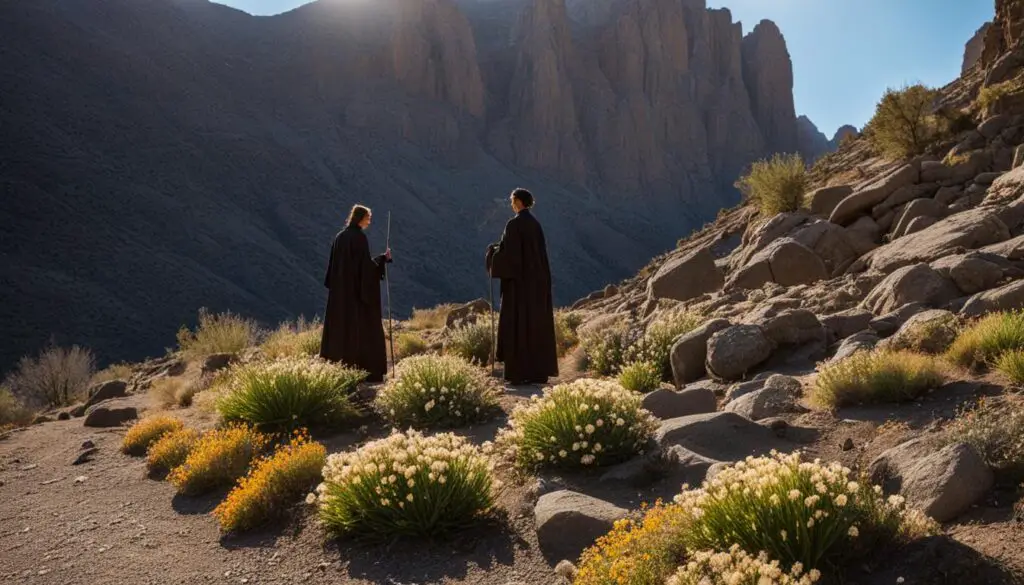
“The purpose of monasticism is the transformation of the individual and, through this, the transformation of society.” – Thomas Merton
The Roots in the Bible
The roots of monasticism can be found in various passages of the Bible that emphasize the importance of solitude, prayer, and devotion to God. In the Old Testament, we see examples of individuals like Moses, Elijah, and David withdrawing to the wilderness to seek God’s presence. The New Testament also presents Jesus’ own retreats into solitude and his teachings on the value of prayer and detachment from worldly possessions.
The Place: The Desert as Sacred Space
The desert held a special place in the development of monasticism. It was seen as a sacred space, a place where monks could experience solitude, silence, and detachment from worldly distractions. The harsh natural environment of the desert also served as a metaphor for the spiritual struggles and challenges that monks faced in their journey towards God.
The Purpose: Pursuit of Prayer and Counter-cultural Values
The primary purpose of monasticism was to pursue a life of prayer and contemplation. Monks sought to deepen their relationship with God and grow in spiritual maturity. Additionally, monasticism presented an alternative way of life that challenged the values and priorities of secular society. By embracing poverty, chastity, and obedience, monks sought to live out the teachings of Jesus and bear witness to the transformative power of the Gospel.
The Procedure: Solitude and Communal Living
Monasticism allowed for both solitary and communal living. Some monks chose to dwell in solitude, seeking complete detachment from the world in order to focus solely on their spiritual journey. Others formed communities, where they lived together in shared pursuit of holiness and mutual support. These communities provided structure, guidance, and accountability, while also fostering a sense of belonging and solidarity among the monks.
| Key Aspects of Monasticism | Examples from the Bible |
|---|---|
| Solitude and Withdrawal | Elijah on Mount Horeb (1 Kings 19), Jesus in the wilderness (Matthew 4) |
| Prayer and Devotion | David’s Psalms, Jesus’ teaching on prayer (Matthew 6) |
| Detachment from Worldly Possessions | Jesus’ teachings on riches (Matthew 19), Rich Young Ruler (Luke 18) |
Shapers of Later Monasticism
In the development of monasticism, two figures stand out as influential shapers of the movement: Basil of Caesarea and Benedict of Nursia. Their teachings and contributions have left a lasting impact on the monastic tradition, guiding the practices and ideals of later monastic communities.
Basil of Caesarea
Basil of Caesarea, also known as Basil the Great, played a significant role in the development of Eastern monasticism. As a bishop and theologian, he emphasized the importance of communal living and asceticism. Basil’s writings, such as his Rules and Letters, provided a foundation for Eastern Orthodox practice.
Benedict of Nursia
Benedict of Nursia is widely regarded as the father of Western monasticism. He established the famous Rule of Saint Benedict, a guidebook for monastic life that emphasized the values of poverty, chastity, and obedience. The Benedictine monastic communities that followed this rule became renowned for their commitment to prayer, work, and study.
| Shapers of Later Monasticism | Influences | Contributions |
|---|---|---|
| Basil of Caesarea | Emphasized communal living and asceticism | Established foundational rules for Eastern monasticism |
| Benedict of Nursia | Emphasized values of poverty, chastity, and obedience | Established the influential Rule of Saint Benedict |
“The monastic tradition owes a great debt to Basil of Caesarea and Benedict of Nursia. Their teachings and rules continue to shape the lives of monks and nuns around the world, providing a framework for spiritual growth and discipline.” – Monastic scholar
These two figures, Basil of Caesarea and Benedict of Nursia, not only laid the foundation for later monasticism but also inspired numerous reform movements. These reformers sought to return to the purity and simplicity of their teachings, ensuring that the monastic tradition remains a vibrant and relevant spiritual path in the present day.
Influential Monastic Figures in History
Throughout history, there have been key leaders, spiritual teachers, and reformers who have significantly influenced the practice and ideals of monasticism. Their teachings and examples have inspired countless individuals to embark on the monastic path, seeking a deeper connection with God and a more intentional way of living.
Key Leaders
One of the influential monastic figures in history is Saint Anthony of Egypt. Known as the Father of Monasticism, Anthony lived as a hermit in the Egyptian desert during the third and fourth centuries. His radical commitment to a life of prayer and asceticism attracted numerous followers and laid the foundation for the monastic movement.
Another prominent monastic leader is Saint Benedict of Nursia. He established the Rule of Benedict, a guide for monastic life that emphasized stability, obedience, and community. The Rule had a profound impact on Western monasticism and continues to be followed by Benedictine communities to this day.
Spiritual Teachers
Saint John Cassian, a monk and theologian of the fifth century, played a crucial role in transmitting the teachings of the Desert Fathers to the Western world. His writings on monasticism, such as “Conferences” and “Institutes,” provided practical guidance for monks and shaped the spirituality of medieval monastic orders.
Another influential spiritual teacher is Saint Teresa of Avila, a 16th-century Spanish mystic and reformer. Through her writings, such as “The Interior Castle” and “The Way of Perfection,” she offered profound insights into the journey of the soul and advocated for a deeper contemplative life.
Reformers
Saint Bernard of Clairvaux, a 12th-century French abbot, was a significant reformer who revitalized monasticism and played a pivotal role in the Cistercian Order. His writings, including “On Loving God” and “Sermons on the Song of Songs,” emphasized the importance of love and devotion in the monastic life.
Elizabeth Ann Seton, an 18th-century American religious sister, is considered a reformer in the context of female monasticism. As the founder of the Sisters of Charity of St. Joseph, she established a new model for religious community life in the United States, focusing on education, healthcare, and service to the poor.
These influential figures in monasticism have left a lasting impact on the Christian tradition, shaping the practice and values of monastic life. Their teachings continue to inspire individuals who seek a deeper spiritual connection and a more intentional way of living in today’s world.
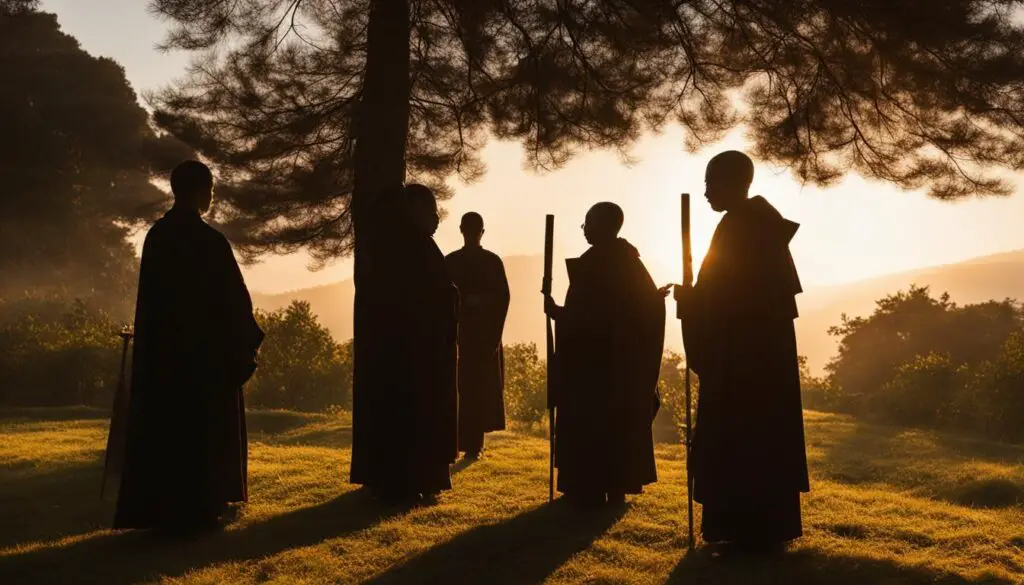
Conclusion
In conclusion, exploring the key figures in monasticism provides a comprehensive understanding of the historical, cultural, and spiritual significance of monasticism. From the early Desert Fathers to the modern monastic communities, these figures have shaped the practice and values of monasticism, leaving a lasting impact on the Christian tradition.
The legacy of monasticism continues to inspire individuals seeking a deeper connection with God and a more intentional way of living. By studying the lives and teachings of these influential monastic figures, one can gain insights into the transformative power of prayer, asceticism, and communal living. Monasticism remains a vibrant and relevant path for those who desire to embrace a disciplined and contemplative life.
By understanding the roots and development of monasticism, we can appreciate the enduring legacy of these men and women who dedicated their lives to seeking God and serving humanity. Their commitment to spiritual disciplines, pursuit of holiness, and contributions to various fields have shaped the course of Christian history and continue to inspire individuals today. Whether through the ancient practices of the Desert Fathers or the innovative approaches of modern monastic communities, the influence of these key figures in monasticism is undeniable.
FAQ
What is monasticism?
Monasticism is a structured, ascetic pursuit of the Christian life involving spiritual disciplines such as silence, chastity, prayer, fasting, confession, good works, obedience, and vigils.
How did monasticism originate?
Monasticism can be traced back to early influences such as Jewish ascetics like the Nazirites, the Qumran Community, the Essenes, and the Therapeutae.
Who were the early monastic figures?
The early monastic figures include the Desert Fathers, such as Anthony of Egypt, Basil of Caesarea, and Benedict of Nursia.
What were the unique practices of Celtic monasticism?
Celtic monks were known for their emphasis on peregrination, rich book production, and early missionary work in the British Isles and France.
What is new monasticism?
New monasticism refers to modern monastic communities that recognize their connection to the tradition of monasticism and offer a fresh perspective on its relevance in today’s world.
When did monasticism start to spread rapidly?
Monasticism started to expand rapidly in the fourth century, with figures like Isaac of Egypt, Anthony of Egypt, and Pachomius playing significant roles.
What were the beginnings of monasticism?
The beginnings of monasticism can be traced back to the roots in the Bible and the cultural context of the time, with individuals seeking a life of prayer and challenging the values of secular society.
Who were the shapers of later monasticism?
Basil of Caesarea and Benedict of Nursia played significant roles in shaping later monasticism, with Basil founding Eastern monasticism and Benedict establishing the Rule that became the guide for Western monastic practice.
Who were some influential monastic figures in history?
Throughout history, there have been many influential monastic figures, including leaders, spiritual teachers, and reformers who have shaped the practice and ideals of monasticism.





